外显子组测序ppt课件
- 格式:pptx
- 大小:1.61 MB
- 文档页数:10
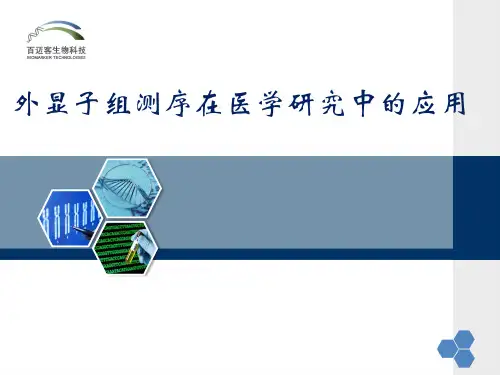
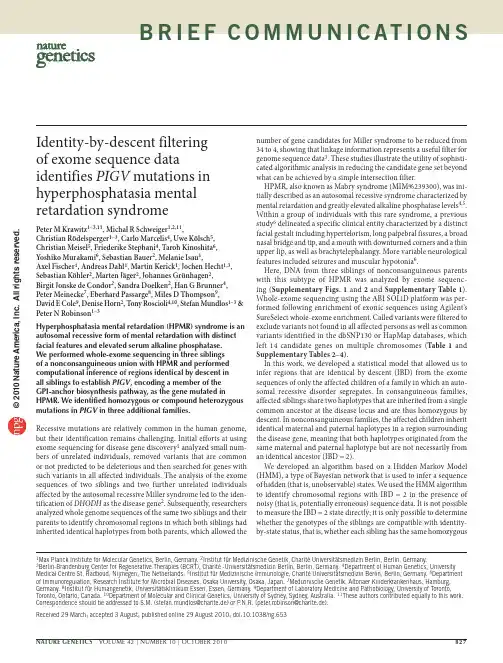
b r i e fc o m m u n i c at i o n sHyperphosphatasia mental retardation (HPMR) syndrome is an autosomal recessive form of mental retardation with distinct facial features and elevated serum alkaline phosphatase. We performed whole-exome sequencing in three siblings of a nonconsanguineous union with HPMR and performed computational inference of regions identical by descent in all siblings to establish PIGV , encoding a member of the GPI-anchor biosynthesis pathway, as the gene mutated in HPMR. We identified homozygous or compound heterozygous mutations in PIGV in three additional families.Recessive mutations are relatively common in the human genome, but their identification remains challenging. Initial efforts at using exome sequencing for disease gene discovery 1 analyzed small num-bers of unrelated individuals, removed variants that are common or not predicted to be deleterious and then searched for genes with such variants in all affected individuals. The analysis of the exome sequences of two siblings and two further unrelated individuals affected by the autosomal recessive Miller syndrome led to the iden-tification of DHODH as the disease gene 2. Subsequently, researchers analyzed whole genome sequences of the same two siblings and their parents to identify chromosomal regions in which both siblings had inherited identical haplotypes from both parents, which allowed thenumber of gene candidates for Miller syndrome to be reduced from 34 to 4, showing that linkage information represents a useful filter for genome sequence data 3. These studies illustrate the utility of sophisti-cated algorithmic analysis in reducing the candidate gene set beyond what can be achieved by a simple intersection filter.HPMR, also known as Mabry syndrome (MIM%239300), was ini-tially described as an autosomal recessive syndrome characterized by mental retardation and greatly elevated alkaline phosphatase levels 4,5. Within a group of individuals with this rare syndrome, a previous study 6 delineated a specific clinical entity characterized by a distinct facial gestalt including hypertelorism, long palpebral fissures, a broad nasal bridge and tip, and a mouth with downturned corners and a thin upper lip, as well as brachytelephalangy. More variable neurological features included seizures and muscular hypotonia 6.Here, DNA from three siblings of nonconsanguineous parents with this subtype of HPMR was analyzed by exome sequenc-ing (Supplementary Figs. 1 and 2 and Supplementary Table 1). Whole-exome sequencing using the ABI SOLiD platform was per-formed following enrichment of exonic sequences using Agilent’s SureSelect whole-exome enrichment. Called variants were filtered to exclude variants not found in all affected persons as well as common variants identified in the dbSNP130 or HapMap databases, which left 14 candidate genes on multiple chromosomes (Table 1 and Supplementary Tables 2–4).In this work, we developed a statistical model that allowed us to infer regions that are identical by descent (IBD) from the exome sequences of only the affected children of a family in which an auto-somal recessive disorder segregates. In consanguineous families, affected siblings share two haplotypes that are inherited from a single common ancestor at the disease locus and are thus homozygous by descent. In nonconsanguineous families, the affected children inherit identical maternal and paternal haplotypes in a region surrounding the disease gene, meaning that both haplotypes originated from the same maternal and paternal haplotype but are not necessarily from an identical ancestor (IBD = 2).We developed an algorithm based on a Hidden Markov Model (HMM), a type of Bayesian network that is used to infer a sequence of hidden (that is, unobservable) states. We used the HMM algorithm to identify chromosomal regions with IBD = 2 in the presence of noisy (that is, potentially erroneous) sequence data. It is not possible to measure the IBD = 2 state directly; it is only possible to determine whether the genotypes of the siblings are compatible with identity-by-state status, that is, whether each sibling has the same homozygousIdentity-by-descent filtering of exome sequence dataidentifies PIGV mutations in hyperphosphatasia mental retardation syndromePeter M Krawitz 1–3,11, Michal R Schweiger 1,2,11,Christian Rödelsperger 1–3, Carlo Marcelis 4, Uwe Kölsch 5, Christian Meisel 5, Friederike Stephani 4, Taroh Kinoshita 6, Yoshiko Murakami 6, Sebastian Bauer 2, Melanie Isau 1,Axel Fischer 1, Andreas Dahl 1, Martin Kerick 1, Jochen Hecht 1,3, Sebastian Köhler 2, Marten Jäger 2, Johannes Grünhagen 2, Birgit Jonske de Condor 2, Sandra Doelken 2, Han G Brunner 4, Peter Meinecke 7, Eberhard Passarge 8, Miles D Thompson 9,David E Cole 9, Denise Horn 2, Tony Roscioli 4,10, Stefan Mundlos 1–3 & Peter N Robinson 1–31Max Planck Institute for Molecular Genetics, Berlin, Germany. 2Institut für Medizinische Genetik, Charité Universitätsmedizin Berlin, Berlin, Germany.3Berlin-Brandenburg Center for Regenerative Therapies (BCRT), Charité -Universitätsmedizin Berlin, Berlin, Germany. 4Department of Human Genetics, UniversityMedical Centre St. Radboud, Nijmegen, The Netherlands. 5Institut für Medizinische Immunologie, Charité Universitätsmedizin Berlin, Berlin, Germany. 6Department of Immunoregulation, Research Institute for Microbial Diseases, Osaka University, Osaka, Japan. 7Medizinische Genetik, Altonaer Kinderkrankenhaus, Hamburg, Germany. 8Institut für Humangenetik, Universitätsklinikum Essen, Essen, Germany. 9Department of Laboratory Medicine and Pathobiology, University of Toronto, Toronto, Ontario, Canada. 10Department of Molecular and Clinical Genetics, University of Sydney, Sydney, Australia. 11These authors contributed equally to this work. Correspondence should be addressed to S.M. (stefan.mundlos@charite.de) or P .N.R. (peter.robinson@charite.de).Received 29 March; accepted 3 August; published online 29 August 2010; doi:10.1038/ng.653© 2010 N a t u r e A m e r i c a , I n c . A l l r i g h t s r e s e r v e d.b r i e fc o m m u n i c at i o n sor heterozygous genotype, a situation which we refer to as IBS*. In our model, every genetic locus was either IBD = 2 or IBD ≠ 2. The HMM was then used to predict the most likely sequence of IBD = 2 or IBD ≠ 2 chromosomal segments on the basis of the observed exome sequences of two or more affected siblings (Supplementary Fig. 1 and Supplementary Methods ).HMM analysis decreased the search space to about 20% of the tran-scribed genome, reducing the number of candidate genes with muta-tions present in all three siblings from 14 to 2 (Table 1, Supplementary Table 5 and Supplementary Figs. 3–5). The two mutations, c.[859G>A]+[859G>A] in SLC9A1 and c.[1022C>A]+[1022C>A] in PIGV , were located within a 13-Mb homozygous block that was part of a larger 35-Mb IBD = 2 block. Runs of homozygosity of up to 4 Mb can occur in the European population even in individuals with no shared ancestors in the previous five to ten generations 7. Both variants were confirmed with ABI Sanger sequencing and were not detected in 200 healthy, unrelated central European individuals. Further homozygous and compound heterozygous mutations were detected in PIGV in individuals from the families designated B 8, C 9 and D 10 (Supplementary Note and Supplementary Tables 6 and 7). All of these missense mutations affect evolutionarily highly conserved residues of PIGV (Fig. 1a ).PIGV, the second mannosyltransferase in the GPI anchor bio-synthesis pathway 11, appeared to be of particular interest because alkaline phosphatase is a GPI-anchored protein. Over 100m ammalian proteins are modified by a glycosylphosphatidylinosi tol (GPI) anchor at their C terminus. The highly conserved back-bone structure of the GPI anchor is synthesized in the endoplasmicr eticulum through at least nine sequential reaction steps mediated by at least 18 proteins. GPI-anchored proteins comprise functionally divergent classes including hydrolytic enzymes, receptors, adhesion molecules and proteins with roles in the immune system 12. Little is known to date about the phenotypic consequences of mutationsof the GPI pathway in mammals. Abrogation of GPI biosynthesis in mice by knockdown of Piga , which encodes a protein that is involved in the first step of GPI-anchor biosynthesis, results in embryonic lethality 13. Somatic loss-of-function mutations in PIGA in hematopoietic stem cells are associated with paroxysmaln octurnal hemoglobinuria 14, primarily because the progeny of affected stem cells are deficient in the GPI-anchored complement regulatory proteins CD55 and CD59, leading to the intravascular hemolysis characteristic of the disease. A promoter mutation in PIGM , encoding a subunit of the complex transferring the first mannose, reduces PIGM expression by over 90% and leads to an autosomal recessive syndrome characterized by hepatic venous thrombosis and absence seizures 15.Defects in the GPI biosynthesis pathway can result in down-regulation of GPI-anchored proteins but not necessarily in a uniform reduction of all such proteins 12. We therefore examined the surface expression of the GPI anchor itself on leukocytes of three indivi-duals with HPMR using Alexa488-conjugated inactivated aerolysin (FLAER). All three subjects showed a substantial reduction of GPI-anchor expression. Correspondingly, expression of the GPI-anchored protein CD16 was markedly reduced (Supplementary Fig. 6). Wild-type PIGV cDNA and PIGV cDNA containing the p.Ala341Glu alteration were transiently transfected into PIGV-deficient Chinese hamster ovary (CHO) cells 11 to assess their effect on protein expression. Cells transfected with themutant constructdid not restore surface expression of GPI-anchored marker proteins (Fig. 1b ), possibly because expressed PIGV protein levels were substantially reduced (Fig. 1c ).Human Mouse Rat Dog Cow Horse FrogZebrafishLumenPIGVCytosolNH 2p.Gln256Lysp.Ala341Glu p.Ala341ValCD59CD55GAPDH12337 kD37 kDPIGV0.0011.50.4p.His385Pro QAHCOOHab cfigure 1 Identification of PIGV mutations in individuals with HPMRsyndrome. (a ) The homozygous PIGV mutation c.[1022C>A]+[1022C>A]; p.[Ala341Glu]+[Ala341Glu] was detected via whole exome sequencing in family A. Further homozygous and compound heterozygous mutations affecting evolutionarily highly conserved residues were found in threeunrelated families: c.[1022C>A]+[1154A>C]; p.[Ala341Glu]+[His385Pro] in family B, c.[766C>A]+[766C>A]; p.[Gln256Lys]+[Gln256Lys] in family C, and c.[1022C>A]+[1022C>T]; p.[Ala341Glu]+[Ala341Val] in family D. (b ) PIGV-deficient CHO cells were transiently transfected with wild-type (dashed lines) or p.Ala341Glu mutant (solid lines) PIGV cDNA in a weak expression vector or the empty vector (gray shadow). Wild-type PIGV efficiently restored the surface expression of CD59 (left) and CD55 (right), whereas p.Ala341Glu mutant PIGV induced only very low levels of CD59 and CD55. (c ) PIGV protein levels were assessed 2 d after transfection of a control vector (lane 1), wild-type PIGV (lane 2) and PIGV with p.Ala341Glu (lane 3). The numbers beneath the gel indicate the relative intensity of PIGV to GAPDH expression.table 1 number of genes with nonsynonymous variants and acceptor or donor splice site mutationsA1A2A3A1 & A2 & A3FilterHomozygous heterozygous All Homozygous heterozygous All Homozygous heterozygous All Homozygous heterozygous All NS/SS2,7529343,3852,9001,0903,6402,8061,0703,6251,7282731,928Not in dbSNP13018235216218472622003823512214IBD = 2165212052517623202Sanger validated22Reducing the search space to the identical by descent (IBD = 2) regions and filtering out all common variants decreased the number of genes with nonsynonymous variants and acceptor or donor splice site mutation to two candidate genes. NS, nonsynonymous; SS, acceptor or donor splice site mutations.© 2010 N a t u r e A m e r i c a , I n c . A l l r i g h t s r e s e r v e d .b r i e fc o m m u n i c at i o n sIn summary, we have identified PIGV mutations in HPMR using whole-exome capture and SOLiD sequencing in combination with an HMM algorithm to identify regions with IBD = 2 in siblings affected with autosomal recessive disorders. Our algorithm can be used in combination with other bioinformatic filters to streamline gene dis-covery in future exome sequencing projects.Accession codes. The mutations in this work were numbered according to transcripts available in GenBank under the codes NM_003047.3 (SLC9A1) and NM_017837.2 (PIGV ).Note: Supplementary information is available on the Nature Genetics website.ACKNowlEDGMENTSThis work was supported by a grant from the Deutsche Forschungsgemeinschaft (SFB 665) to S.M., by a grant from Bundesministerium für Bildung und Forschung (BMBF , project number 0313911) and an Australian National Health and Medical Research Council international research training fellowship to T.R., and by a grant of the Canadian Institutes of Health Research and Epilepsy Canada to M.D.T. We thank B. Fischer, U. Kornak, M. Ralser, E. van Beusekom, U. Marchfelder and D. Lefeber for their assistance in this project.AUTHoR CoNTRIBUTIoNSM.R.S., M.I. and A.D. performed targeted exome resequencing. P .M.K., C.R., A.F., M.K., S.B., S.K., M.J. and P .N.R. performed bioinformatic analysis. P .M.K., C. Marcelis, J.G., B.J.d.C., F.S. and T.R. performed mutation analysis andgenotyping. D.H., C. Marcelis, M.D.T., D.E.C., S.D., P .M., E.P ., T.R. and H.G.B.contributed to clinical evaluation of the affected individuals and delineation of the phenotype. P .M.K., U.K. and C. Meisel performed flow cytometric analysis. Y.M. and T.K. performed analysis of wild-type and A341E PIGV clones. P .M.K., M.R.S., D.H., J.H., H.G.B., P .N.R. and S.M. carried out the project planning and preparation of the manuscript.CoMPETING FINANCIAl INTERESTSThe authors declare no competing financial interests.Published online at /naturegenetics/.Reprints and permissions information is available online at /reprintsandpermissions/.1. Ng, S.B. et al. Nat. Genet. 42, 30–35 (2010).2. Ng, S.B. et al. Nature 461, 272–276 (2009).3. Roach, J.C. et al. Science 328, 636–639 (2010).4. Mabry, C.C. et al. J. Pediatr. 77, 74–85 (1970).5.Kruse, K., Hanefeld, F ., Kohlschutter, A., Rosskamp, R. & Gross-Selbeck, G. J. Pediatr. 112, 436–439 (1988).6. Horn, D., Schottmann, G. & Meinecke, P . Eur. J. Med. Genet. 53, 85–88 (2010).7. McQuillan, R. et al. Am. J. Hum. Genet. 83, 359–372 (2008).8. Rabe, P . et al. Am. J. Med. Genet. 41, 350–354 (1991).9. Marcelis, C.L., Rieu, P ., Beemer, F . & Brunner, H.G. Clin. Dysmorphol. 16, 73–76(2007).10. Thompson, M.D. et al. Am. J. Med. Genet. 152a , 1661–1669 (2010).11. Kang, J.Y. et al. J. Biol. Chem. 280, 9489–9497 (2005).12. Kinoshita, T., Fujita, M. & Maeda, Y. J. Biochem. 144, 287–294 (2008).13. Nozaki, M. et al. Lab. Invest. 79, 293–299 (1999).14. Takeda, J. et al. Cell 73, 703–711 (1993).15. Almeida, A.M. et al. Nat. Med. 12, 846–851 (2006).© 2010 N a t u r e A m e r i c a , I n c . A l l r i g h t s r e s e r v e d.。

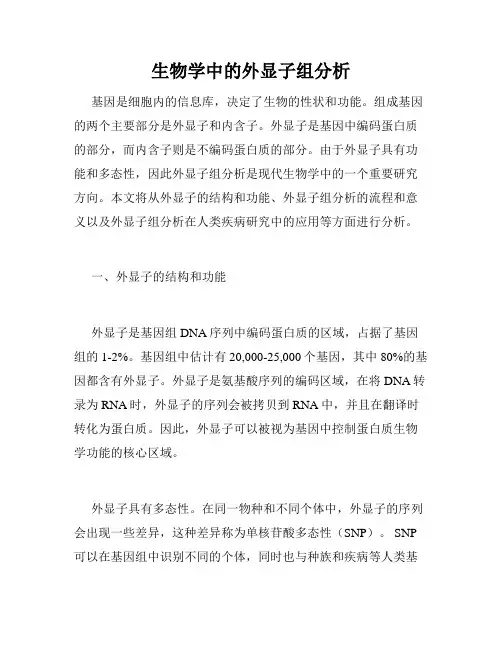
生物学中的外显子组分析基因是细胞内的信息库,决定了生物的性状和功能。
组成基因的两个主要部分是外显子和内含子。
外显子是基因中编码蛋白质的部分,而内含子则是不编码蛋白质的部分。
由于外显子具有功能和多态性,因此外显子组分析是现代生物学中的一个重要研究方向。
本文将从外显子的结构和功能、外显子组分析的流程和意义以及外显子组分析在人类疾病研究中的应用等方面进行分析。
一、外显子的结构和功能外显子是基因组DNA序列中编码蛋白质的区域,占据了基因组的1-2%。
基因组中估计有20,000-25,000个基因,其中80%的基因都含有外显子。
外显子是氨基酸序列的编码区域,在将DNA转录为RNA时,外显子的序列会被拷贝到RNA中,并且在翻译时转化为蛋白质。
因此,外显子可以被视为基因中控制蛋白质生物学功能的核心区域。
外显子具有多态性。
在同一物种和不同个体中,外显子的序列会出现一些差异,这种差异称为单核苷酸多态性(SNP)。
SNP 可以在基因组中识别不同的个体,同时也与种族和疾病等人类基因和表型变异相关。
因此,外显子具有高度的多态性和特异性,是了解人类基因和表型变异的重要基础。
二、外显子组分析的流程和意义外显子组分析是通过对基因组DNA的测序,筛选出基因组中的外显子区域,确定外显子的序列和位置,进而对外显子序列和SNP进行研究和分析的过程。
外显子组分析分为三部分:实验操作、数据分析和生物学信息学分析。
实验操作包括DNA提取、文库构建、测序和文库质量检查等,主要采用先进的高通量测序技术,如Illumina HiSeq和ABI Solid等。
数据分析是对文库测序结果的处理和解读,包括序列质控、序列比对和SNP检测等。
生物学信息学分析是对数据进行挖掘和分析,包括基因功能注释、SNP特性分析、外显子组的生物学功能和进化关系分析等。
外显子组分析是解读基因功能、研究人类表型和疾病的最新方法之一。
外显子组分析的结果可用于寻找特定外显子序列和SNP,了解疾病相关的基因变异和表型特点。
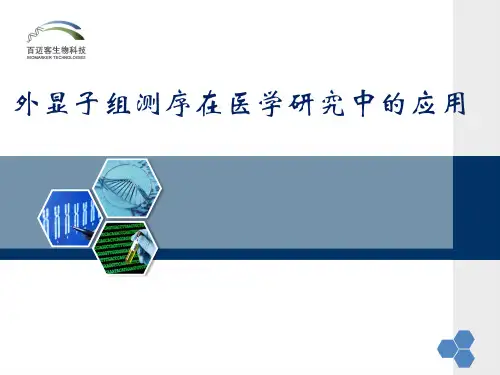



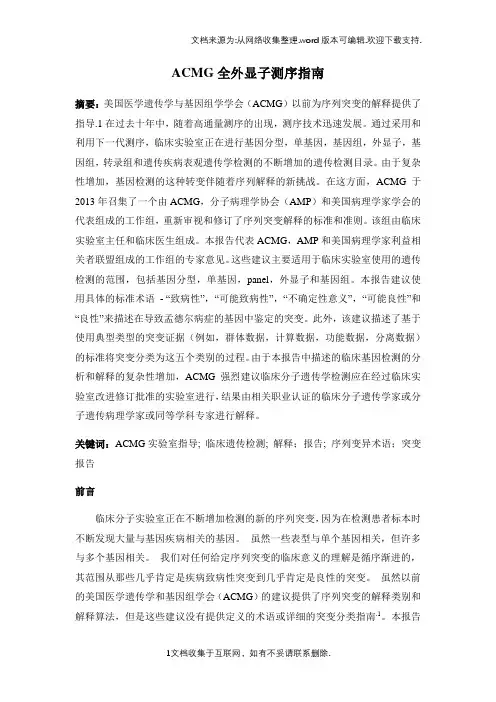
ACMG全外显子测序指南摘要:美国医学遗传学与基因组学学会(ACMG)以前为序列突变的解释提供了指导.1在过去十年中,随着高通量测序的出现,测序技术迅速发展。
通过采用和利用下一代测序,临床实验室正在进行基因分型,单基因,基因组,外显子,基因组,转录组和遗传疾病表观遗传学检测的不断增加的遗传检测目录。
由于复杂性增加,基因检测的这种转变伴随着序列解释的新挑战。
在这方面,ACMG于2013年召集了一个由ACMG,分子病理学协会(AMP)和美国病理学家学会的代表组成的工作组,重新审视和修订了序列突变解释的标准和准则。
该组由临床实验室主任和临床医生组成。
本报告代表ACMG,AMP和美国病理学家利益相关者联盟组成的工作组的专家意见。
这些建议主要适用于临床实验室使用的遗传检测的范围,包括基因分型,单基因,panel,外显子和基因组。
本报告建议使用具体的标准术语- “致病性”,“可能致病性”,“不确定性意义”,“可能良性”和“良性”来描述在导致孟德尔病症的基因中鉴定的突变。
此外,该建议描述了基于使用典型类型的突变证据(例如,群体数据,计算数据,功能数据,分离数据)的标准将突变分类为这五个类别的过程。
由于本报告中描述的临床基因检测的分析和解释的复杂性增加,ACMG强烈建议临床分子遗传学检测应在经过临床实验室改进修订批准的实验室进行,结果由相关职业认证的临床分子遗传学家或分子遗传病理学家或同等学科专家进行解释。
关键词:ACMG实验室指导; 临床遗传检测; 解释;报告; 序列变异术语;突变报告前言临床分子实验室正在不断增加检测的新的序列突变,因为在检测患者标本时不断发现大量与基因疾病相关的基因。
虽然一些表型与单个基因相关,但许多与多个基因相关。
我们对任何给定序列突变的临床意义的理解是循序渐进的,其范围从那些几乎肯定是疾病致病性突变到几乎肯定是良性的突变。
虽然以前的美国医学遗传学和基因组学会(ACMG)的建议提供了序列突变的解释类别和解释算法,但是这些建议没有提供定义的术语或详细的突变分类指南.1。


什么是全外显子组测序与全基因组测序?全基因组测序可谓是基因组最为全面的研究方案。
基因组信息已能用于鉴定遗传疾病,查找驱使癌症发展的突变,追踪疾病的爆发。
迅速下降的测序成本以及处理大样本数据能力的提升都使得如今的测序者可将全基因组测序视为基因组研究的最强有力工具。
全基因组测序常被理解为用于测定人类基因组,然而新一代测序技术(NGS)的规模、灵活性体现于可以在任何物种上高效运用测序技术,如农业畜牧业,植物,或疾病相关微生物。
利用二代测序技术,对大量DNA片段进行测序就完全可行了。
例如,一部分DNA片段含有蛋白质合成的密码“指令”,这部分片段被称作“外显子”(exon)。
目前认为,外显子只占到人类基因组的大约1%,基因组中所有的外显子被统称为“外显子组”(exome),对这部分序列的测序就被称为“全外显子组测序”。
这种方法能够检测出所有基因的蛋白质编码区域的变异,而不仅仅是被选择的有限的若干基因。
由于已知的大多数导致疾病的突变均发生在外显子中,全外显子组测序从而被认为是一种高效的识别可能致病的突变的方法。
但是,近年来研究人员发现,外显子区域以外的DNA序列也可以影响基因活性,继而影响蛋白质的表达,导致疾病发生。
然而,这些突变若利用全外显子组测序并不能检测到。
因此,另一种称为“全基因组测序”的方法出现了,这种方法可以读取到个体所有DNA核苷酸的序列,即可以检测出基因组任何部分的变异。
相比于选择性的基因测序,全外显子组测序与全基因组测序能够发现更多的基因变异,但显然会有相当一部分的变异的意义是不明确的。
并不是所有的基因变异都会影响健康,因此很难断定某些检测出的变异是否与患者的疾病、表型等相关。
有时,一种被识别出的基因变异还可能与另一种尚未被诊断的遗传疾病有关(被称为“偶然”或“继发发现”,incidentalor secondary findings)。
除了在临床上应用外,全外显子组测序和全基因组测序对于研究人员来说也是非常有价值的,研究人员对外显子组和基因组序列的持续关注可以帮助他们确定新的基因变异是否与人的健康状况有关,这将有助于未来的疾病诊断。
外显子外显子(英语expressed region)是真核生物基因的一部分,它在剪接(Splicing)后仍会被保存下来,并可在蛋白质生物合成过程中被表达为蛋白质。
外显子是最后出现在成熟RNA中的基因序列,又称表达序列。
既存在于最初的转录产物中,也存在于成熟的RNA分子中的核苷酸序列。
术语外显子也指编码相应RNA外显子的DNA中的区域。
所有的外显子一同组成了遗传信息,该信息会体现在蛋白质上。
外显子-基因反应剪接方式并不是唯一的(参看替代剪接),所以外显子只能在成体mRNA中被看出。
即使是使用生物信息学方法,要精确预测外显子的位置也是非常困难的。
真核生物的基因,其线性表达被内含子阻断,这就是所谓的断裂基因(英语splitgene),该现象的发现者RichardJ.Roberts和PhillipA.Sharp获得了1993年诺贝尔奖。
在反式剪接中,不同mRNA的外显子可以被接合在一起。
外显子在剪接(Splicing)后仍会被保存下来,并可在蛋白质生物合成过程中被表达为蛋白质。
外显子是最后出现在成熟RNA 中的基因序列,又称表达序列。
既存在于最初的转录产物中,也存在于成熟的RNA分子中的核苷酸序列。
术语外显子也指编码相应RNA外显子的DNA中的区域。
简言之,外显子就是指真核细胞的基因在表达过程中能编码蛋白质的核苷酸序列。
关键概念:比较不同物种的相关基因,发现相应的外显子序列通常是保守的,而内含子序列则很少保守。
编码蛋白质的序列通常处于选择压力之下,内含子由于没有选择压力,因此比外显子的进化快得多。
通过确定在多种生物中出现的片段来鉴定编码区域,而外显子的保守性可以作为这种鉴定的基础。
人类大部分基因组序列都是被垃圾DNA序列分隔成一段段,给定一个已知的目标蛋白质和基因组序列,在该基因组序列中找出一组子字符串(候选外显子),使得其拼接(剪接)与目标蛋白质最匹配(即去掉垃圾DNA序列)。
一个强力方法是寻找基因组序列与目标蛋白质序列间的所有局部相似性。